7 Major Ports in Latvia
The Republic of Latvia is a small yet significant Baltic nation situated in Northern Europe. It has a high-income economy and is a part of many international organisations.
Located on the eastern shores of the Baltic Sea, Latvia is also an important tourist destination known for its lush green plains, mountains and lakes. The nation boasts world-class infrastructure and its citizens enjoy a high standard of living.
National Economic growth is driven by the service sector industries such as transportation, information technology, and financial services followed by manufacturing, food processing and metalworking.
Latvia has three major seaports and multiple small harbours and marinas catering to fishing vessels, boats, yachts and cruise ships.
Let us have a look at the port infrastructure of Latvia.
1. Liepaja Port
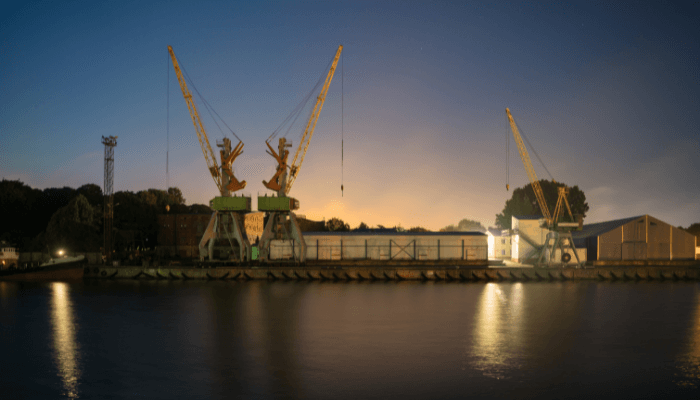
Liepaja is one of the biggest cities in Latvia with age-old manufacturing traditions. It has a strong industrial sector driven by excellent infrastructure, skilled labour and new technological innovations.
Most processing industries are located near the Liepaja port which translates to low logistics costs and increased trade routes for shipping manufactured items to the European Union and the Commonwealth of Independent States. Also, the companies enjoy the numerous direct and indirect tax benefits offered by the Liepaja Special Economic Zone.
Liepaja enjoys a strategic position on the Baltic coast and remains ice-free throughout the year. The port has facilities for dealing with agro-based products, construction material, timber, biofuel, metals, fertilisers, bulk and liquid cargo. Additionally, the port renders services to RORO Carriers, passenger ferries, fishing vessels and yachts.
It is also an important transhipment centre, handling transit cargo from Russia, Kazakhstan, Belarus and other CIS nations.
Port Specifications
Liepaja port covers 1182 hectares, divided among its 80 specialised berths covering 10,000 m. It can accommodate ships with an overall length of 240 m and a draught of 11 m.
Storage spaces include 440,000 m2 of open storage yards, 100,000 m2 of warehouse space, 75,000 m3 of liquid cargo reservoirs, silos for keeping 74,400 m3 of grains and cold storage with a capacity for 25,000 m3 of perishable goods.
In 2021, the port was visited by 1652 ships carrying 4724,000 tonnes of dry bulk, 545,000 tonnes of liquid cargo and 1786,500 tonnes of general cargo. It handled 142.7 thousand TEUs and 1268 thousand tonnes of RORO in the same year.
Port terminals
Dry bulk terminals, namely the Liepaja Bulk Terminal LTD and LSEZ Ltd. handle agricultural cargoes arriving in short-sea shipping vessels and Panamax ships. Transhipment cargo is dealt with at the specialised facility called the Baltic Transhipment Centre, operated by LSEZ Ltd.
Terrabalt terminal specialises in dealing with project cargo, including machine parts, windmills etc. The CEMEX terminal handles cement cargo transhipments and is connected to the ports in Sweden and Finland. A passenger terminal with a 550 m wharf serves passenger ferries and small boats sailing from Liepaja to Travemunde, Germany.
Three terminal facilities operated by LSEZ Limited, handle wood materials such as wood chips, wooden pellets and logs. Wooden logs and high-quality sawn wood are transhipped from the Duna and Laksana terminals.
The multi-modal port company, Ekers Stividors LP provides transhipment of coal, packed fertilisers, metals and some types of breakbulk cargo. Crude oil is handled at the DG Terminal and refined oil products at the GI terminal are operated by Glen oil.
2. Port of Riga
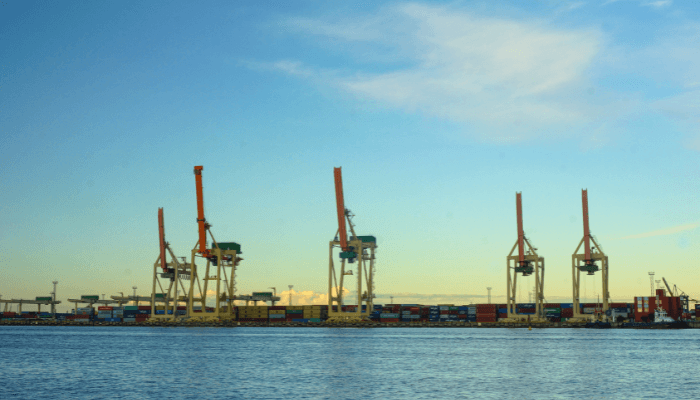
Riga port lies on the eastern Baltic coast at the mouth of the Daugava river around 15 kilometres inland from the Gulf of Riga. The largest port of Latvia, it is also the second biggest port in the Baltic region.
The port is an integral part of the capital city, covering eleven per cent of its territory. A major cultural, administrative and financial hub, Riga’s historic centre is a UNESCO World Heritage Site known for its magnificent German Art Nouveau architecture. Hence apart from handling cargo, Riga also accommodates cruise ships and yachts. During the cruise season, Riga port receives more than 80 cruise ships and over 1 million passengers on its world-class passenger terminal.
Riga contributes roughly 50 per cent to the country’s industrial output by manufacturing textiles, foodstuff, furniture, wood products, communication equipment, pharmaceuticals, electrical equipment, machine parts, diesel engines, streetcars etc. The city is also home to prominent publishing houses and IT Companies. Shipbuilding is another dominant economic activity.
Riga port dates back to the 12th century and is strategically positioned. Closest to the Eurasian landmass, it stands at the crossroads of eminent trade routes that have been used since times immemorial. It has developed as a transit facility connecting Latvia with European markets, Russia, Central Asia and China. It provides smart logistics solutions to its customers and acts as a regional distribution centre too.
Port Specifications
Riga port covers 6348 hectares and contains 18 kilometres of berthing line divided among 36 multifunctional cargo terminals. More than 30 shipping agencies operate at Riga port handling timber, containers, agro-based products, metals, fertilisers and oil.
In 2021, the port handled 21.5 million tonnes of cargo and more than 2500 ships. It usually remains ice-free, however, two icebreakers are needed for navigating the ships carefully into the harbour during severe winters. A multimodal facility, it is well-linked with railways and motor access roads.
The port infrastructure is at par with global port standards and can accommodate all ships that can sail through the Danish straits and enter the Baltic Sea, mainly the Panamax and post-Panamax vessels with a maximum draught of 15 m and an LOA of 320 metres.
The port authorities give special attention to regularly upgrading the technological infrastructure of Riga for providing seamless services to partner companies and clients. These measures have gained Riga, the reputation of being the most technologically advanced port in the country.
Riga port has ample storage space including 273,434 m2 of open cargo areas, cold storage capacity for 46,600 m3 of reefer cargo and container yards for keeping 14,000 tonnes of general and bulk cargo.
3. Port of Ventspils
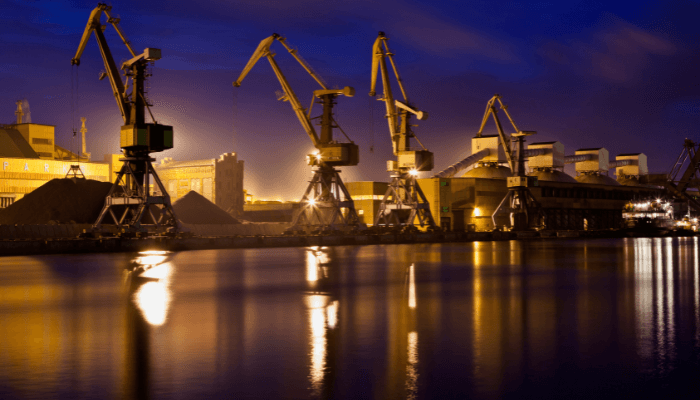
The deepwater port of Ventspils is situated at the mouth of the Venta River and has trade links with European Union countries and Asia. Part of the TEN-T transport network, it handles transit goods destined for Russia and CIS nations.
Chemicals, potassium salt, coal, cereals, RORO, crude oil, refined oil products, fertilisers, forest goods, seafood, and containers are the principal cargoes handled at the port’s 16 specialised terminals.
It does not freeze, hence it is operational all year round, serving the largest vessels plying in the Baltic Sea. It is also connected with the Russian oil pipeline going from Ventspils to Polotsk with an annual capacity of 6,000,000 tonnes. It is also integrated into the East-West railway corridor which is an intrinsic component of the Eurasian transport system that carries 34 million tonnes of cargo to and from the Baltic States, Europe and Asia.
Port Characteristics
Ventspils has an outer harbour protected by moles and a commercial harbour. The port has a 5767 m berthing line and handles 28,500,000 tonnes of cargo, 53,100 passengers and 1,800 vessels annually. The largest ferry operator in Europe, Stena Line operates ferries from Ventspils to Sweden.
Ventspils Freeport also provides marine waste collection services. It is equipped for handling oil waste, garbage and sewage. The port also offers bunkering, ship repair and maintenance services.
The yacht port is located south of the main port entrance and accommodates 50 yachts by a 120 m long mooring place with a water depth of 4 metres. It has 30 berths, a sauna, showers, lounges etc and offers free wifi, laundry, car and watercraft rental services. It also contains a 10,200 m2 yard area and warehouse premises covering 5120 m2.
Close to the freeport’s Harbour Master Service is the fishing pier suitable for 9 m long and 3 m wide fishing boats. It also has a five-tonne crane for lifting and putting fishing boats in the water.
4. Port of Skulte
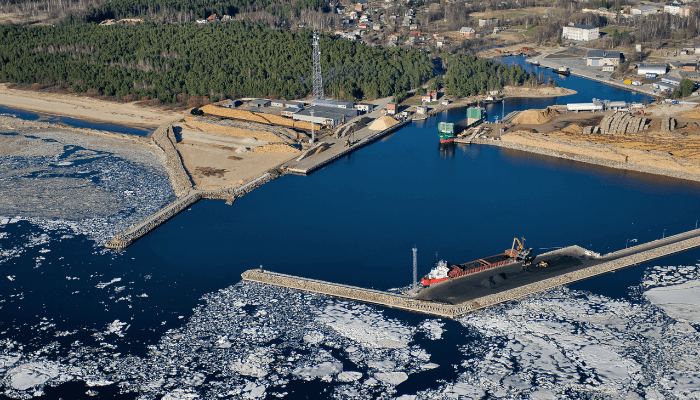
The fourth biggest port of Latvia, Skulte is an important gateway for shipping forest products and has been engaged in transporting round timber, sawn wood, woodchips, industrial salt, aggregates, peat, coal, wood pellets, minerals, grains and mineral fertilisers since 1996.
It has two deepwater quays covering 250 metres, 25 rail cars, truck scales, an 88,000 m2 storage area and 3000 m2 warehouse space for storing 8000 tonnes of cargo.
Skulte port boasts modern infrastructure and functions as a business hub. It lies amidst the Latvian transport corridor that also passes through Riga. It is linked to important roads via the Baltica highway.
Around 500,000 tonnes of cargo pass through the port every year. The authorities are planning to expand the facility by creating additional berths to increase its capacity by more than 1 million tonnes. A 45-hectare industrial area is being developed near the port for housing companies and production units.
5. Mersrags Port
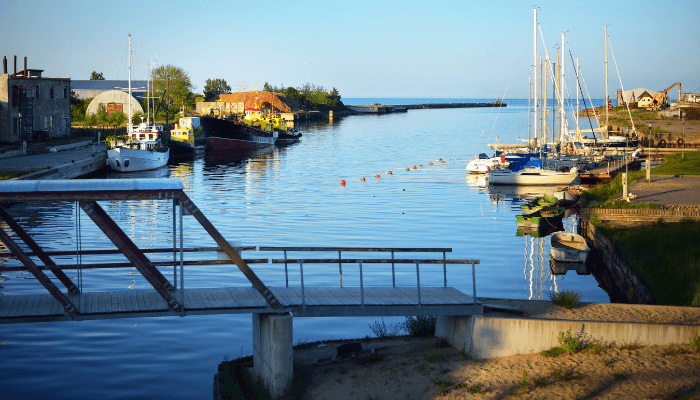
Port of Mersrags lies on the western shores of the Gulf of Riga, just four kilometres south of the Mersrags headland. It is an artificial bay surrounded by a northern and southern pier and is connected to Riga, Talsi, Tukums and Kolka by roads. It covers 78 hectares and comprises 9 berths with a total quay length of 765 metres. The port can accommodate ice-class vessels with a 6.5 m draft and has 2 tug boats.
The port has existed since the 15th century as a small fishing village. In 1927, a fishing pier was constructed and shipping began on the newly-built general cargo wharf the next year. Two breakwaters were built covering 800 metres. During the period of Soviet occupation, the Mersrags port was primarily a fishing harbour housing two seafood processing plants. It was only in 1994, that it began to ship plywood to nearby countries.
Today, the port handles timber, lumber, woodchips, peat and seafood. A 15-hectare logistics park consisting of production facilities and warehouses is being built along with a new grain terminal.
6. Port of Salacgriva
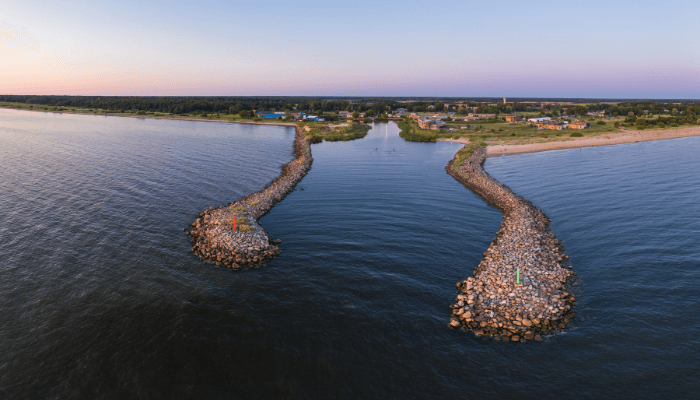
Salacgriva port lies on the northeastern side of the Gulf of Riga near the mouth of the Salaca River, 100 kilometres from Riga and 13 kilometres from the border of Estonia. The farthest north port of the country, Salalcrgiva spans 43 hectares and contains six wharves handling pulp, logs, sawn timber and fish. It was designed to accommodate small cargo ships.
The city is famous for its culture and cuisine, not to forget the Positivus festival that attracts tourists from across the world. The port dates back to the 19th century and was used for exporting agricultural products and timber from Northern Vidzeme. After Latvia gained independence, a fish processing unit was constructed on the premises.
7. Port of Pāvilosta
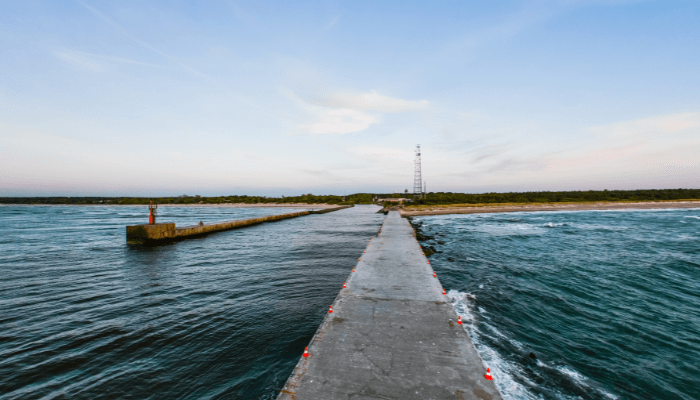
The only port on the western coast of Latvia, Pavilosta is a small facility visited by fishing vessels and yachts. It has a yacht club, two guest marinas equipped with lounges, restrooms, cafes and bathrooms and a seafood processing unit. Yacht berths on the banks of the Saka river can accommodate at least 30 yachts.
It has 4 fishing berths covering 400 m, capable of admitting 70 m long vessels. The marina has 800 m2 of cargo storage area and a fish freezer for storing 90 tonnes. It is equipped with a stationary crane and a service centre.
You might also like to read:
- 10 Major Ports in Jamaica
- 10 Major Ports of Uruguay
- 8 Major Ports in Ecuador
- 6 Major Ports in Denmark
- 6 Major Ports in Iran
Do you have info to share with us ? Suggest a correction

About Author
Shilavadra Bhattacharjee is a shipbroker with a background in commercial operations after having sailed onboard as a Third Officer. His interests primarily lie in the energy sector, books and travelling.
Latest Maritime Knowledge Articles You Would Like:
Subscribe To Our Newsletters
By subscribing, you agree to our Privacy Policy and may receive occasional deal communications; you can unsubscribe anytime.
















